Copper Is Accumulated as Copper Sulfide Particles, and Not Bound to Glutathione, Phytochelatins or Metallothioneins, in the Marine Alga Ulva compressa (Chlorophyta)
Abstract
1. Introduction
2. Results
2.1. U. compressa Metallothioneins (UcMTs)
2.2. Intracellular Accumulation of Copper in Response to Copper, NaHS and Hypotaurine
2.3. Level of GSH and PCs in Response to Copper and NaHS
2.4. Expression of UcMT1.1 Family in Response to Copper and NaHS
2.5. Expression of UcMT2 and UcMT3 in Response to Copper and NaHS
2.6. Accumulation of Intracellular Copper as Copper Sulfide Particles
3. Discussion
4. Materials and Methods
4.1. Sampling of U. compressa
4.2. Culture of U. compressa Treated with Copper, NaHS or Hypotaurine
4.3. Quantification of Intracellular Copper in U. compressa
4.4. Quantification of GSH and PCs by HPLC
4.5. Quantification of the Relative Levels of UcMT Transcripts by qRT-PCR
4.6. Analysis of Copper Sulfide Nanoparticles by TEM-EDX
4.7. Statistical Analyses
Supplementary Materials
Author Contributions
Funding
Data Availability Statement
Conflicts of Interest
Abbreviations
References
- Yadav, S.K. Heavy metal toxicity in plants: An overview on the role of glutathione and phytochelatins in plants. S. Afr. J. Bot. 2010, 76, 167–179. [Google Scholar] [CrossRef]
- Riyazuddin, R.; Nisha, N.; Ejaz, B.; Khan, M.I.; Kumar, M.; Ramteke, P.W.; Gupta, R. A comprehensive review on the heavy metal toxicity and sequestration in plants. Biomolecules 2022, 12, 43. [Google Scholar] [CrossRef]
- Xu, Y.; Feng, L.; Jeffrey, P.D.; Shi, Y.G.; Morel, F.M.M. Structure and metal exchange in the cadmium carbonic anhydrase of marine diatoms. Nature 2008, 452, 56–61. [Google Scholar] [CrossRef]
- Edwards, C.D.; Beatty, J.C.; Loiselle, J.B.R.; Vlassov, K.A.; Lefebvre, D.D. Aerobic transformation of cadmium through metal sulfide biosynthesis in photosynthetic microorganisms. BMC Microbiol. 2013, 13, 161. [Google Scholar] [CrossRef]
- Xu, H.; Zhang p He, E.; Peijnenburg, J.G.M.; Cao, X.; Zhao, L.; Xu, X.; Qiu, H. Natural formation of copper sulfide nanoparticles via microbially mediated organic sulfur mineralization in soil: Processes and mechanisms. Geoderma 2023, 116, 300. [Google Scholar] [CrossRef]
- Liu, P.H.; Huang, Z.Y.; Luo, X.H.; Chen, H.; Weng, B.Q.; Wang, Y.X.; Chen, L.S. Comparative transcriptome analysis reveals candidate genes related to cadmium accumulation and tolerance in two almond mushroom (Agaricus brasilensis) strains with contrasting cadmium tolerance. PLoS ONE 2020, 15, 239617. [Google Scholar]
- Cobbet, C.; Goldsbrough, P. Phytochelatins and metallothioneins in heavy metal detoxification and homeostasis. Annu. Rev. Plant Biol. 2002, 53, 159–182. [Google Scholar] [CrossRef]
- Li, Z.H.; Lu, Y.P.; Zhen, R.G.; Szypcka, M.; Thiele, D.J.; Rea, P.A. A new pathway for vacuolar cadmium sequestration in Saccharomyces cerevisiae: YCF1-catalyzed of (bis-glutathione) cadmium. Proc. Natl. Acad. Sci. USA 1997, 94, 42–47. [Google Scholar] [CrossRef]
- Mendoza-Cózatl, D.G.; Romero-Sánchez, R. Cd+2 transport and storage in the chloroplasts of Euglena gracilis. Biochim. Biophys. Acta 2005, 1706, 88–97. [Google Scholar] [CrossRef]
- Shukla, D.; Kesari, R.; Mishra, S.; Dwivedi, S.; Tripathi, R.D.; Nath, P.; Trivedi, P.K. Expression of phytochelatin synthase from aquatic macrophyte Ceratophyllum demersum L. enhances cadmium and arsenic accumulation in tobacco. Plant Cell Rep. 2012, 31, 1687–1699. [Google Scholar] [CrossRef]
- Zhu, S.; Shi, W.; Jie, Y. Overexpression of BnPCS1, a novel phytochelatin synthase gene from ramie (Boehmeria nivea), enhanced cadmium tolerance, accumulation, and translocation in Arabidopsis thaliana. Front. Plant Sci. 2021, 12, 639198. [Google Scholar] [CrossRef]
- Li, M.; Leso, M.; Buti, M.; Bellini, E.; Bertoldi, D.; Saba, A.; Larcher, R.; Sanita de Toppi, L.; Varotto, C. Phytochelatin synthase de-regulation in Marchantia polymorpha indicates cadmium detoxification as its primary ancestral function in land plants and provides a novel and visual bioindicator for detection of this metal. J. Hazard. Mat. 2022, 440, 129844. [Google Scholar] [CrossRef]
- Guo, W.J.; Meetam, M.; Goldsbrough, P.B. Examining the specific contribution of individual Arabidopsis metallothioneins to copper distribution and metal tolerance. Plant Physiol. 2008, 164, 1697–1706. [Google Scholar] [CrossRef]
- Zhang, P.H.; Zhang, X.J.; Tang, T.W.; Hu, H.L.; Bai, N.N.; Zhang, D.W.; Meng, S.; Peng, J.S. Isolation of three metallothionein genes and their role in mediating cadmium resistance. Agronomy 2022, 12, 2971. [Google Scholar] [CrossRef]
- Bennatti, M.R.; Yookongkaev, N.; Meetam, M.; Guo, W.J.; Punyasuk, N.; Abu Qamar, S.; Goldsbrough, P. Metallothionein deficiency impacts copper accumulation and redistribution in leaves and seeds of Arabidopsis. New Phytol. 2014, 202, 940–951. [Google Scholar] [CrossRef]
- Ratkevicius, N.; Correa, J.A.; Moenne, A. Copper accumulation, synthesis of ascorbate and activation of ascorbate peroxidase in Enteromorpha compressa (L.) Grev. (Chlorophyta) from heavy metal-enriched environments in northern Chile. Plant Cell Environ. 2003, 26, 1599–1608. [Google Scholar] [CrossRef]
- Navarrete, A.; González, A.; Gómez, M.; Contreras, R.A.; Díaz, P.; Lobos, G.; Brown, M.T.; Sáez, C.A.; Moenne, A. Copper excess detoxification is mediated by a coordinated induction of glutathione, phytochelatins and metallothioneins in the green seaweed Ulva compressa. Plant Physiol. Biochem. 2019, 135, 423–431. [Google Scholar] [CrossRef]
- Zúñiga, A.; Laporte, D.; González, A.; Gómez, M.; Sáez, C.A.; Moenne, A. Isolation and characterization of copper- and zinc-binding metallothioneins from the marine alga Ulva compressa (Chlorophyta). Int. J. Mol. Sci. 2020, 21, 153. [Google Scholar] [CrossRef]
- Osorio, H.; Tapia-Reyes, P.; Espinoza, D.; Laporte, D.; González, A.; Castro-Nallar, E.; Moenne, A. The genome of the marine alga Ulva compressa (Chlorophyta) reveals protein-coding genes with similarity to plants, green microalgae, but also to animal, bacterial and fungal genes. Int. J. Mol. Sci. 2022, 23, 7279. [Google Scholar] [CrossRef]
- Das, U.; Rahman, A.; Ela, E.J.; Lee, K.W.; Kabir, A.H. Sulfur triggers glutathione and phytochelatins accumulation causing excess Cd bound to cell walls of roots in alleviating Cd-toxicity in alfalfa. Chemosphere 2021, 262, 128361. [Google Scholar] [CrossRef]
- Jia, H.; Wang, X.; Dou, Y.; Liu, D.; Si, W.; Fang, H.; Zhao, C.; Chen, S.; Xi, J.; Li, J. Hydrogen sulfide-cysteine cycle system enhances cadmium tolerance through alleviating cadmium-induced oxidative stress and ion toxicity in Arabidopsis roots. Sci. Rep. 2016, 6, 39702. [Google Scholar] [CrossRef] [PubMed]
- Corpas, F.J.; González-Gordo, S.; Cañas, A.; Palma, J.M. Nitric oxide and hydrogen sulfide in plants: Which come first? J. Exp. Bot. 2019, 17, 4391–4404. [Google Scholar] [CrossRef] [PubMed]
- Corpas, F.J.; González-Gordo, S.; Muñoz-Vargas, M.A.; Rodríguez-Ruiz, M.; Palma, J.M. The modus operandi of hydrogen sulfide (H2S)-dependent protein persulfidation in higher plants. Antioxidants 2021, 10, 1686. [Google Scholar] [CrossRef] [PubMed]
- Liu, X.L.; Chen j Wang, G.H.; Wang, W.H.; Shen, Z.J.; Luo, M.R.; Gao, G.F.; Simon, M.; Gotho, K.; Zheng, H.L. Hydrogen sulfide alleviates zinc toxicity by reducing zinc uptake and regulating genes expression of antioxidative enzymes and metallothioneins in roots of the Cd/Zn hyperaccumulator Solanum nigrum L. Plant Soil 2015, 400, 177–192. [Google Scholar] [CrossRef]
- Ali, B.; Gill, R.A.; Yang, S.; Gill, M.B.; Ali, S.; Rafiq, M.T.; Zhou, W. Hydrogen sulfide alleviates cadmium-induced morpho-pysiological and ultrastructural changes in Brassica napus. Ecol. Environ. Saf. 2020, 110, 197–207. [Google Scholar] [CrossRef] [PubMed]
- Aroca, A.; Benito, J.M.; Gotor, C.; Romero, L.C. Persulfidation proteome reveals the regulation of protein function by hydrogen sulfide in diverse biological processes in Arabidopsis. J. Exp. Bot. 2017, 68, 4915–4927. [Google Scholar] [CrossRef] [PubMed]
- Jurado-Flores, A.; Aroca, A.; Romero, L.C.; Gotor, C. Sulfide promotes tolerance to drought through protein persulfidation in Arabidopsis. J. Exp. Bot. 2023, 74, 4654–4669. [Google Scholar] [CrossRef]
- Yastreb, T.O.; Kolupaev, Y.E.; Havva, E.N.; Horielova, E.I.; Dimitriev, A.P. Involvement of the JIN1/MYC2 transcription factor in inducing salt resistance in Arabidopsis plants by exogenous hydrogen sulfide. Cytol. Genet. 2020, 2, 96–102. [Google Scholar] [CrossRef]
- Ansarypour, Z.; Shapiri, A. Heterologous expression of a rice metallothionein isoform (OsMTI-1b) in Saccharomyces cerevisiae enhances cadmium, hydrogen peroxide and ethanol tolerance. Braz. J. Microbiol. 2017, 48, 537–543. [Google Scholar] [CrossRef]
- Yu, X.Z.; Lin, Y.J.; Zhang, Q. Metallothioneins enhance chromium detoxification through scavenging ROS and stimulating metal chelation in Oryza sativa. Chemosphere 2019, 220, 300–313. [Google Scholar] [CrossRef]
- Zhao, J.; Xie, R.; Lin, J.; Xu, L.; Gao, X.; Lin, X.; Tian, S.; Lu, L. SaMT3 in Sedum alfredii drives Cd detoxification by chelation and ROS-scavenging via Cys residues. Environ. Pollut. 2022, 315, 120410. [Google Scholar] [CrossRef] [PubMed]
- Espinoza, D.; González, A.; Pizarro, J.; Segura, S.; Laporte, D.; Rodríguez-Rojas Sáez, C.A.; Moenne, A. Ulva compressa from copper-polluted sites exhibits intracellular copper accumulation, increased expression of metallothioneins and copper-containing nanoparticles in chloroplasts. Int. J. Mol. Sci. 2021, 221, 531. [Google Scholar] [CrossRef] [PubMed]
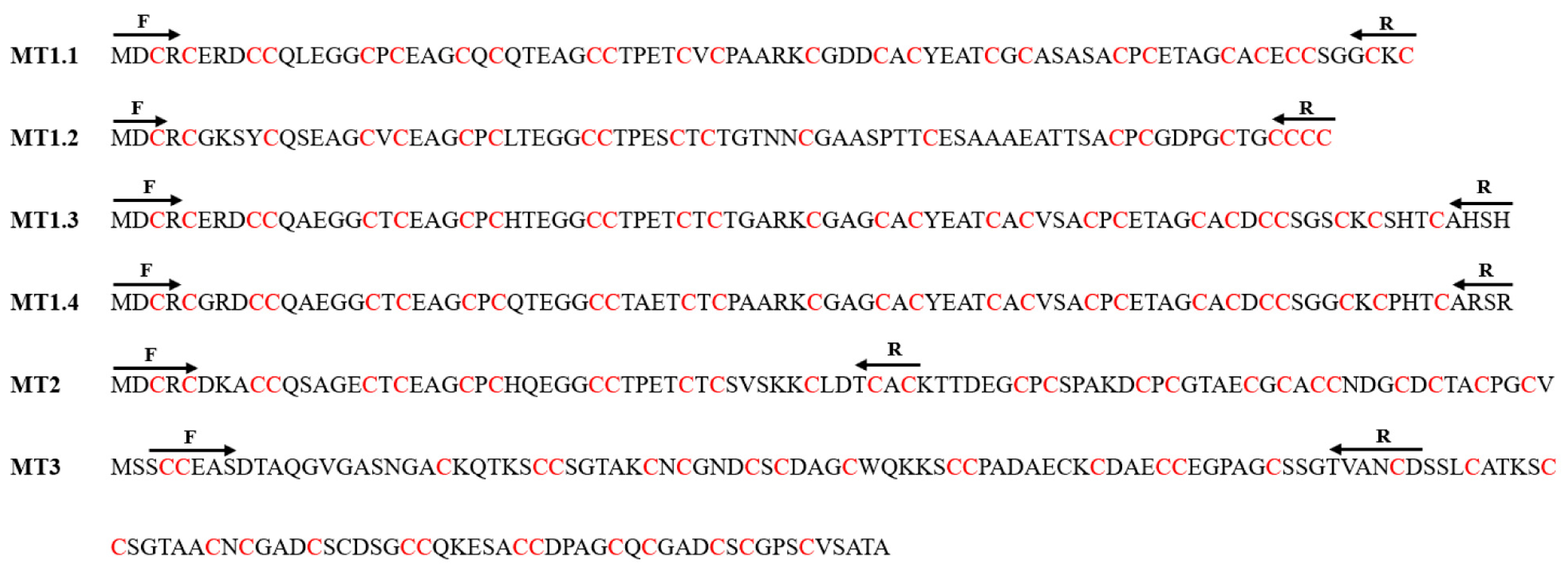
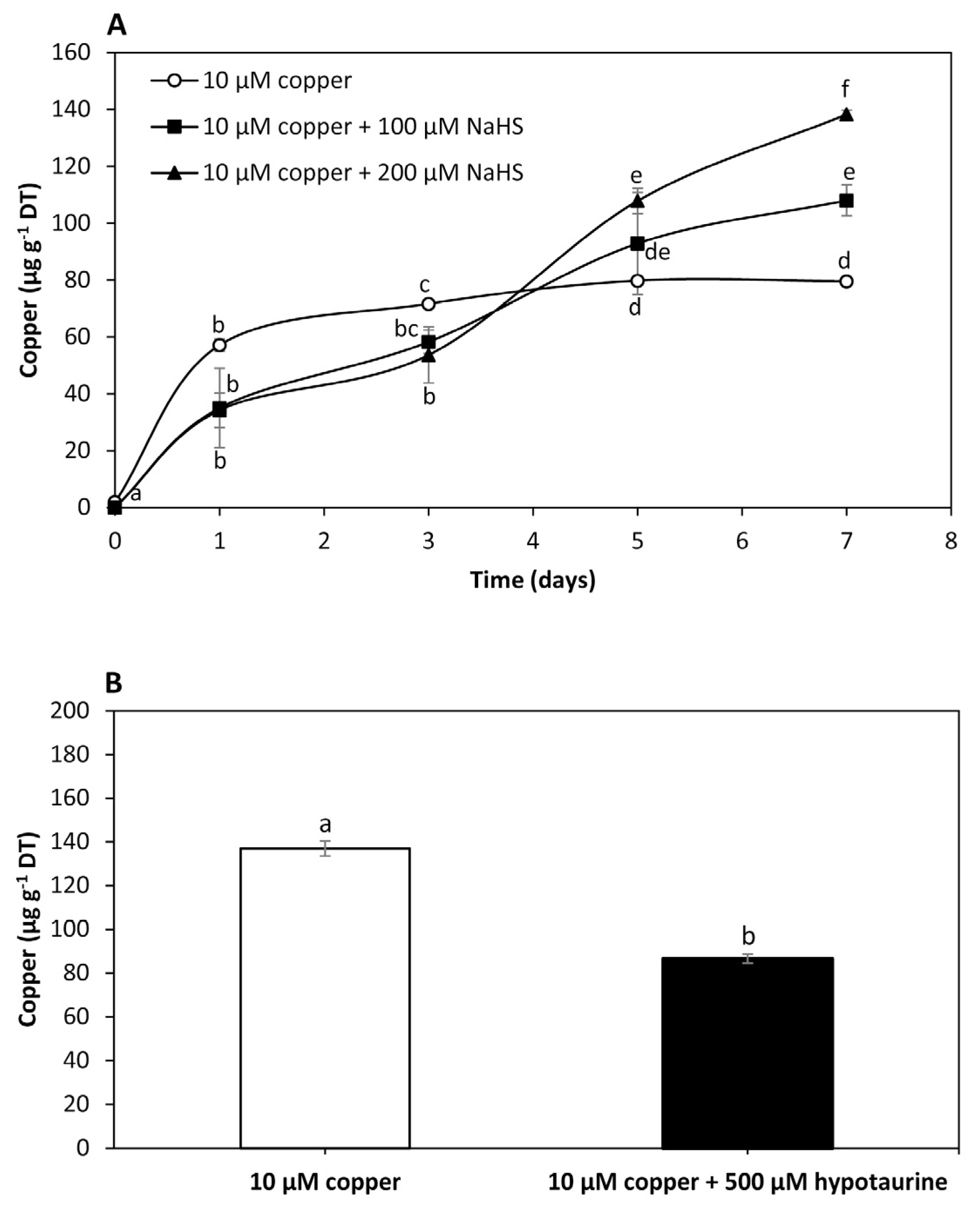

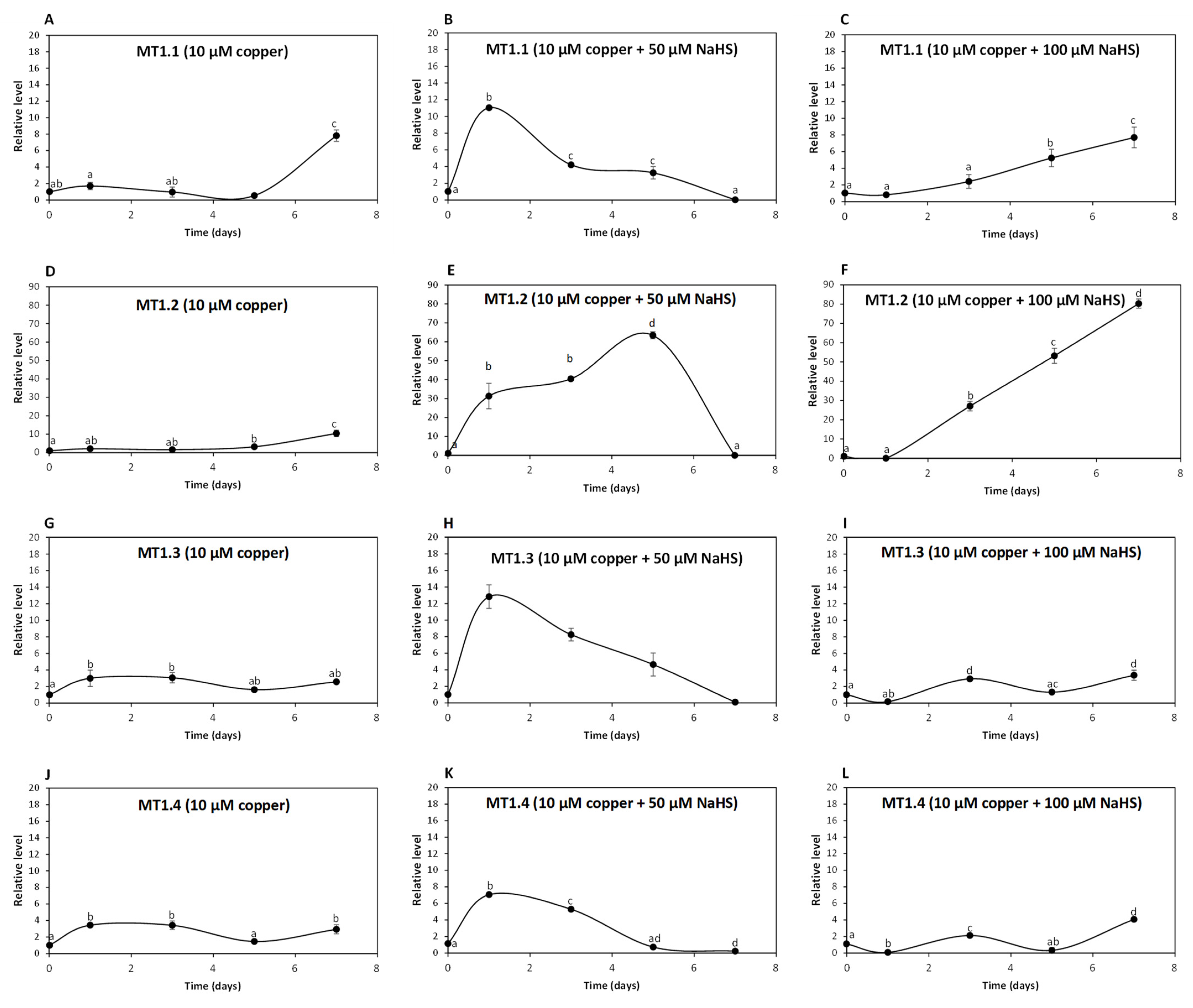

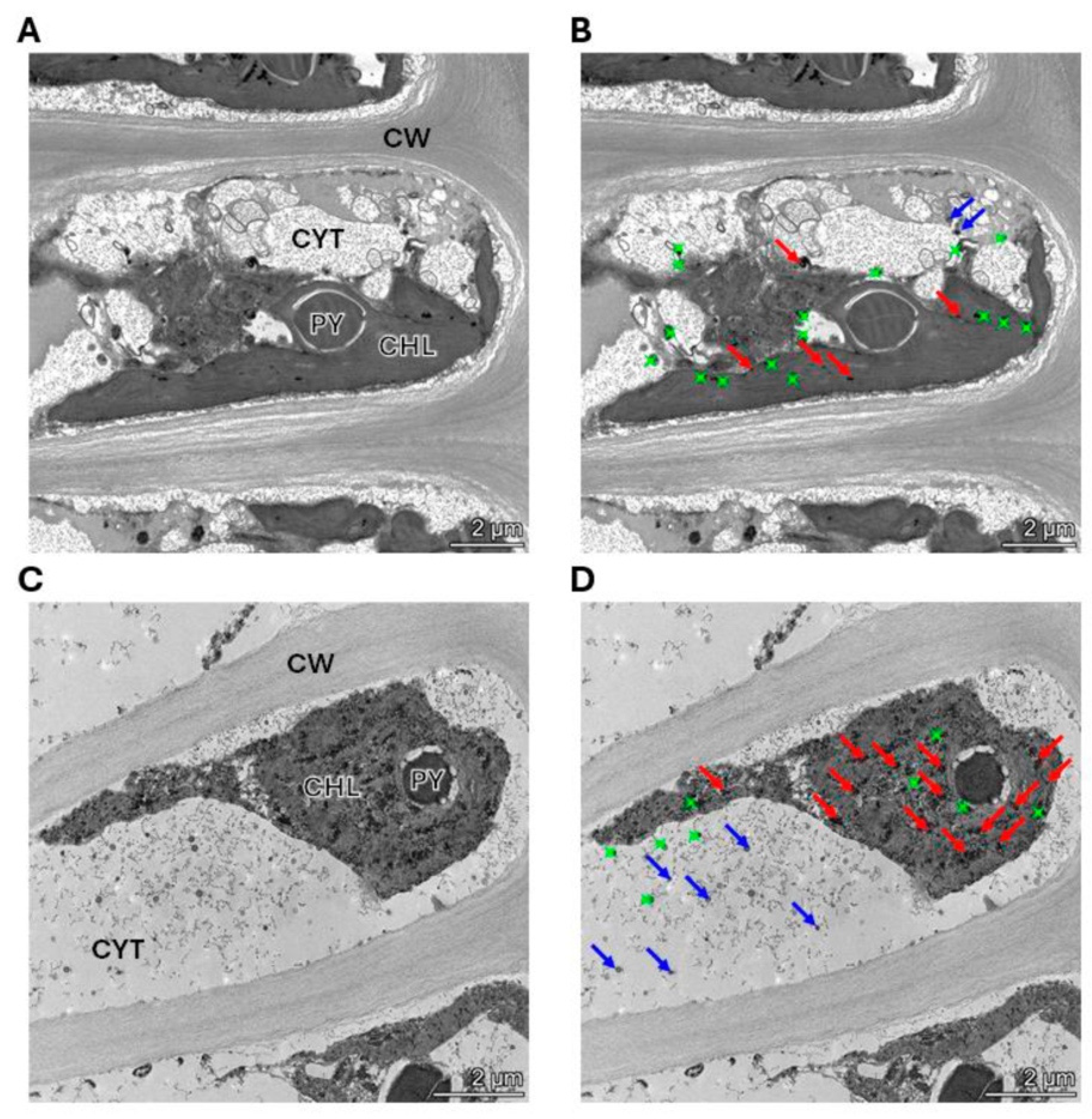
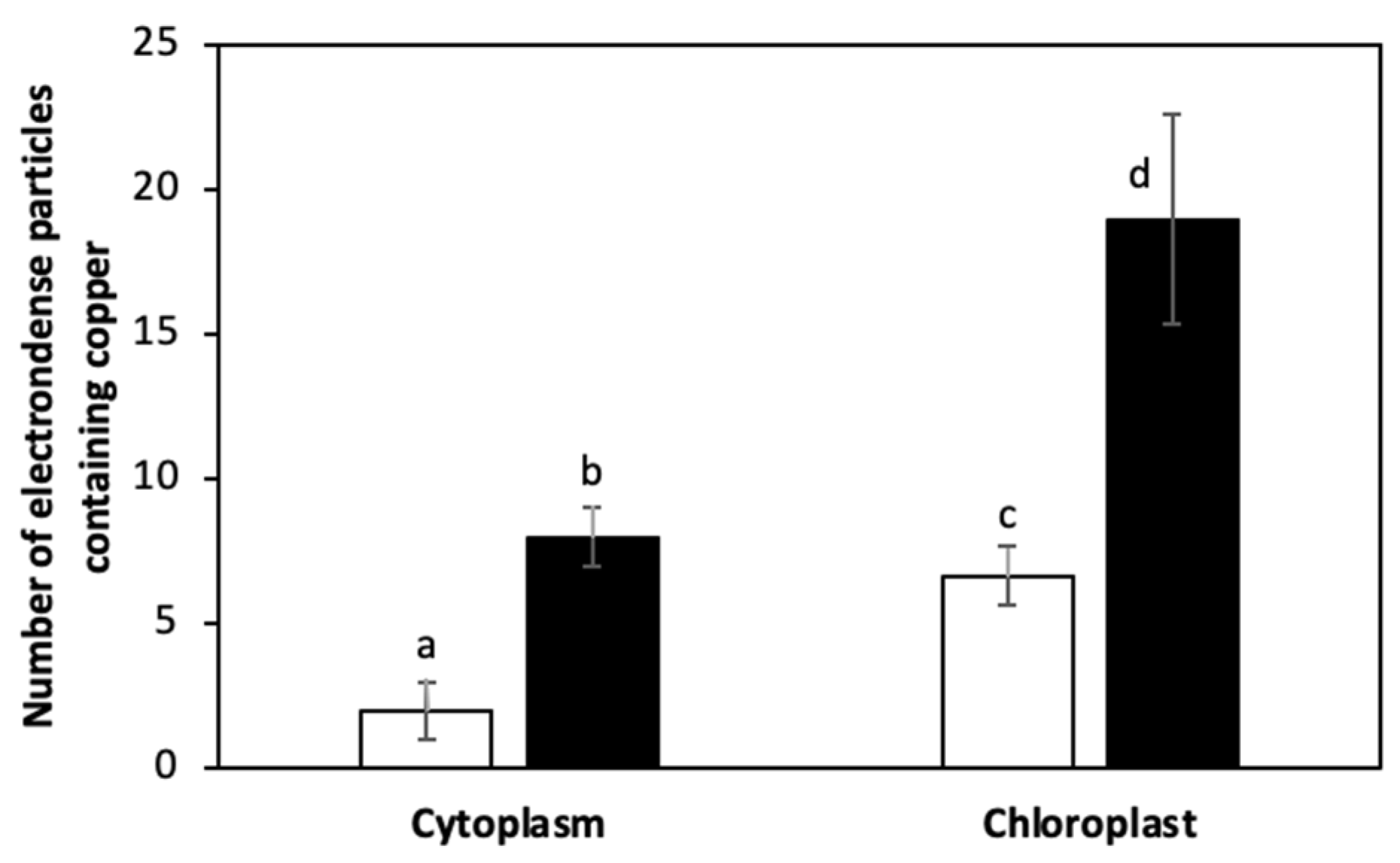
| Metallothioneins | Number of Amino Acids | Molecular Weight (kDa) | Number of Cysteines | Percentage of Cysteines |
|---|---|---|---|---|
| MT1.1 | 81 | 8.2 | 25 | 25 |
| MT1.2 | 77 | 7.5 | 20 | 26 |
| MT1.3 | 89 | 8.7 | 25 | 28 |
| MT1.4 | 87 | 8.6 | 26 | 30 |
| MT2 | 90 | 9.1 | 27 | 30 |
| MT3 | 139 | 13.4 | 34 | 24 |
| Gene | Forward (F) | Reverse (R) |
|---|---|---|
| Tubulin | 5′-TGCAACTTTTGTAGGCAACTC-3′ | 5′-CAGTGAACTCCATCTCGTCC-3′ |
| MT1.1 | 5′-CATGGACTGCCGTTGCG-3′ | 5′-AGCTAGCACTTGCAACCG C-3′ |
| MT1.2 | 5′-CATCATGGATTGCCGCTG-3′ | 5′-ATCAGCAGCAGCAGCAGC-3′ |
| MT1.3 | 5′-CATGGACTGCCGTTGCG-3′ | 5′-AGCTAGTGCGAGTGAGCGC-3′ |
| MT1.4 | 5′-CATGGACTGCCGTTGCG-3′ | 5′-CATCTAGCGCGAGCGAGC-3′ |
| MT2 | 5′-ATGGACTGCCGTTGCGAC-3′ | 5′-TCTTGCAGGCGCAGGTG-3′ |
| MT3 | 5′-TCTTGTTGTGAAGCCAGTGA-3′ | 5′-CACAGTTGCATTCTGCGGTT-3′ |
Disclaimer/Publisher’s Note: The statements, opinions and data contained in all publications are solely those of the individual author(s) and contributor(s) and not of MDPI and/or the editor(s). MDPI and/or the editor(s) disclaim responsibility for any injury to people or property resulting from any ideas, methods, instructions or products referred to in the content. |
© 2024 by the authors. Licensee MDPI, Basel, Switzerland. This article is an open access article distributed under the terms and conditions of the Creative Commons Attribution (CC BY) license (https://creativecommons.org/licenses/by/4.0/).
Share and Cite
Romero, S.; González, A.; Osorio, H.; Segura, R.; Moenne, A. Copper Is Accumulated as Copper Sulfide Particles, and Not Bound to Glutathione, Phytochelatins or Metallothioneins, in the Marine Alga Ulva compressa (Chlorophyta). Int. J. Mol. Sci. 2024, 25, 7632. https://doi.org/10.3390/ijms25147632
Romero S, González A, Osorio H, Segura R, Moenne A. Copper Is Accumulated as Copper Sulfide Particles, and Not Bound to Glutathione, Phytochelatins or Metallothioneins, in the Marine Alga Ulva compressa (Chlorophyta). International Journal of Molecular Sciences. 2024; 25(14):7632. https://doi.org/10.3390/ijms25147632
Chicago/Turabian StyleRomero, Stephanie, Alberto González, Héctor Osorio, Rodrigo Segura, and Alejandra Moenne. 2024. "Copper Is Accumulated as Copper Sulfide Particles, and Not Bound to Glutathione, Phytochelatins or Metallothioneins, in the Marine Alga Ulva compressa (Chlorophyta)" International Journal of Molecular Sciences 25, no. 14: 7632. https://doi.org/10.3390/ijms25147632
APA StyleRomero, S., González, A., Osorio, H., Segura, R., & Moenne, A. (2024). Copper Is Accumulated as Copper Sulfide Particles, and Not Bound to Glutathione, Phytochelatins or Metallothioneins, in the Marine Alga Ulva compressa (Chlorophyta). International Journal of Molecular Sciences, 25(14), 7632. https://doi.org/10.3390/ijms25147632





